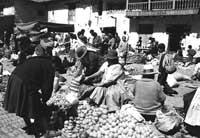Coca and drug trafficking
Colombia, after Brazil, is the second largest producer of coffee and its trade generates almost half of the legal income. But the extra-official “trade” of cocaine also moves huge amounts of money.
You cannot know exactly the benefits of Colombian cartels. According to some studies, the US includes weekly two tons of very good quality coke, which means at least one billion pesetas a year.
The economy of the Andean peoples is not very healthy and coca is easy to grow, so it is a source of gratitude money. The policy of promoting alternative crops has notably failed. The administration of the US. To combat the coquero has spent 81 million dollars (10,530 million pesetas) and has sent the agents of the DEA (experts in anti-drug police); the Peruvian police has also carried out actions against coca, but these measures have not managed to eliminate the coquerías, but are more and more numerous.

In the jungle of Alto Huallaga, in Peru, where half of the world’s coca leaves are produced and considered “barn” of Colombian traffickers, more than 300,000 coca growers grow 200,000 hectares. “The numbers cannot be opposed. With coffee it earns 150,000 pesetas a year and with coca for 195,000 crops; in addition, coca supports four crops a year … Egizu batuka!” This is what the engineer Paredes, technical manager of the cooperative El Naranjillo talks about. This association tried to stop the expansion of the coke in the eighties, bringing together producers of “legal crops”. But today he accepts his failure to what is called “white gold”.
Due to the poor living conditions of Peru, coca consumption in the home is increasingly reduced as a drug. Coca, undervalued by the upper classes for being a popular product, is currently consumed as cocaine worldwide. Peru and Bolivia are the main producers of basic cocaine paste. Colombian cartels process and extract cocaine to the United States and Europe.
Colombian drug traffickers carry out between 80 and 90 weekly flights to the Andean jungles in search of the precious plant. Paying the locals between 20 and 30 dollars a day (the age earned by the farmer in a week) they build clandestine landing strips in the production areas. When the army destroys one of them, they condition another jungle place in a battle that seems unfinished.
The ties between the Colombian cartels and some Peruvian mafias were already known and in 1994 they were revealed when they discovered Peruvian drug trafficker Chávez Peña-Herrera. In his statements to the police, he said that he was engaged in drug trafficking and that he had relations with the Cali cartel, the organization that controls 80% of world cocaine trafficking. In addition, he mentioned the complicity of some officials of the Peruvian Administration and Army.
Relations between drug trafficking and some American governments, including the US, have always been suspicious. In October 1994 the “Conference on Drugs, Development and Rule of Law” was organized at the University of Deusto. Levine, a former DEA agent, clearly denounced that “many senior U.S. officials, aware of this, are scamming. During the last three decades they have convinced their country and many others of the need to stop drug trafficking and, at the same time, they have carried out a covert policy to protect and help the main drug traffickers and whiteners of the planet,” said Levine, who almost all the big U.S. banks have laundered the money of the Medellín Cartel while the government, consciously, did the unknown.”
Buletina
Bidali zure helbide elektronikoa eta jaso asteroko buletina zure sarrera-ontzian











